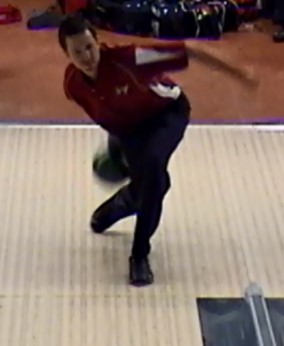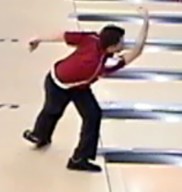Stick the Landing
Stick the Landing
The single most-telling aspect of a bowler's game is the finish position. It's a byproduct of the approach and it will give you all the information needed to analyze what you did right ... and wrong. Few bowlers are aware of the liabilities in their finish position; fewer assess the finish position and trace it backward to what's causing liabilities.
There's a slight difference between the finish position and the overall "posting" of a shot. For the bowler, the critical point is when the ball is coming off the hand; this is the end of the physical act of delivering the ball. "Posting" a shot is the routine immediately after the delivery and is where coaches and players focus primarily on balance and stability.
Let's break down the finish position into pieces and learn to assess the results. The following can be viewed by a coach or by yourself using video.
The Shoulders: The bowling shoulder should be lower than the non-bowling shoulder. Coaches used to urge athletes to keep their shoulders square and level, but that's not the norm any longer. After all, you are swinging a heavy object, so it's natural the bowling shoulder is going to be slightly lower.
The Slide Foot: Make sure that the direction of your slide foot and slide knee are pointing toward the target. You don't want your slide foot pointing one way and your bowling ball and arm swing going the other way. That will affect your balance, which is one of the key elements to a strong finish.

The Hips: Proper hip movement is critical to maintaining proper balance. They're the foundation for consistency and for properly posting your shot. Your slide-foot position is a reference point for the hips. The ball passes your hip on the downswing, and as long as your hips are open and in the direction of the target, you'll have enough room for the swing to come through, and proper hip placement will allow you to stay balanced. Before releasing the ball, the hips should close slightly. In the finish position, you want the hips to be closed down and pointed at your target path.
Trailing Leg: When you get into your swing and the ball passes your hip, the heel of the ball-side foot should point away from the ball-side shoulder. Leading the trail leg with the heel is what opens the hips and allows the ball to come through cleanly. Once the ball clears the hip, the toe of the trailing leg should roll underneath and point away from the ball-side shoulder. This helps close down the hips, and is a move that few bowlers take advantage of. Your lower body helps maintain balance, and you lose strength and leverage when your hips stay open.

Opposite Arm: Be aware of the position of your non-bowling arm, particularly at the finish. The action of that arm is important, too. Is it high and pointing toward the ceiling? Is it pulling back too hard? Is it pointing to the floor? Is it even being used in the shot?
It should balance the momentum generated by the swing arm. So, as your bowling arm is at the height of its backswing, the non-bowling arm should be slightly forward. As the swing comes down to the finish position, the opposite arm should move to the bowlers' side to counterbalance the swing.
The Head: The head should be as stable as possible, with your eyes toward the target path. Your head should never pull left or right leading the shot. When you lead sideways with your head, there's a tendency to bring the rest of your body around the same direction; what suffers will be your balance and swing alignment. Remember, the body goes where your head leads it.
Posture: The overall posture of the bowler is the final indicator. Be aware of whether your finish looks clean. Ask yourself, "Am I too far forward?" "Am I pulling back at the finish?" "Is my finish smooth?" From a coach's perspective, or through video, it's easy to see whether the bowlers' body movement is balanced and efficient.
The Knee: When a bowler finishes with good balance, there's typically a space between their slide knee and trailing knee, which balances the momentum as the swing is completed.
The Follow-through: This can be defined as the arms extension toward the pins. Is it toward the ceiling? More importantly, which direction is the follow-through? Ideally, it's in the direction of the target path. Of course, some great bowlers follow through with their arm across their body. That doesn't necessarily mean the bowler can't repeat but it can be more difficult to repeat effectively.
The Consistent Finish: The key is to see if you can nail the proper finish position and make it a repeatable process. You can usually trace an unbalanced finish position to a flaw in the approach. If you find yourself falling off to one side at the finish, you may take a look at the direction of your push-away or the direction of your arm swing as it comes down to the release.
Each of the "pieces" detailed above plays a role in the finish, and each can be adjusted if they're considered a liability. In the end, make sure your finish feels comfortable and repeatable. Bowling's a game and it shouldn't feel like work.





